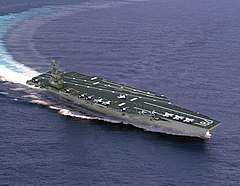Lotniskowce typu Gerald R. Ford
 | |
| Kraj budowy | |
|---|---|
| Użytkownicy | |
| Stocznia | |
| Wejście do służby | 2017- |
| Planowane okręty | 10 |
| Zbudowane okręty | 1 |
| Dane taktyczno-techniczne | |
| Wyporność | ok. 100 000 długich ton (pełna) |
| Długość | 332,8 m |
| Szerokość | 40,8 m (na linii wodnej) |
| Napęd | |
| Prędkość | ponad 30 węzłów |
| Załoga | 4660 |
| Uzbrojenie | |
| Wyposażenie lotnicze | 75-90 samolotów i śmigłowców |
Lotniskowce typu Gerald R. Ford – typ amerykańskich lotniskowców z napędem jądrowym, opracowanych na potrzeby United States Navy, mających zastąpić okręt USS „Enterprise” (CVN-65) oraz jednostki typu Nimitz, stanowiące trzon amerykańskiej floty. Pierwsza jednostka tego typu, USS „Gerald R. Ford” (CVN-78) została zamówiona w 2008 roku, a do służby weszła w 2017 roku[1][2]. Łącznie zbudowanych ma zostać dziesięć okrętów typu Gerald R. Ford[3].
Okręty mają mieć wyporność 100 000 długich ton, długość 332,8 metrów a na pokład mają zabierać 75-90 samolotów i śmigłowców. Podstawowe wyposażenie lotniskowców mają stanowić myśliwce F-35C Lightning II oraz F/A-18E/F Super Hornet, samoloty wczesnego ostrzegania E-2D Hawkeye, samoloty walki elektronicznej EA-18G Growler, śmigłowce MH-60R/S Seahawk/Knighthawk, a także bezzałogowe aparaty latające[3] .
Okręt może operować bez ponownego zasilania przez okres nawet 20 lat[4].
Przewidywany okres służby okrętów wynosi, podobnie jak w przypadku ich poprzedników, 50 lat.
Okręty
- USS „Gerald R. Ford” (CVN-78) – wszedł do służby 22 lipca 2017 roku[2]
- USS „John F. Kennedy” (CVN-79) – planowane wejście do służby w 2025 roku[5]
- USS „Enterprise” (CVN-80)[6] – planowane wejście do służby w 2028 roku[5]
- USS „Doris Miller” (CVN-81) - okręt zamówiony[7]
Przypisy
- ↑ Delivery of US Navy's USS Gerald R Ford aircraft carrier further delayed - Naval Technology. www.naval-technology.com. [dostęp 2015-10-05].
- ↑ a b Paweł Behrendt: USS Gerald R. Ford w służbie (pol.). konflikty.pl. [dostęp 2017-07-26].
- ↑ a b CVN 78 Gerald R Ford Class – US Navy CVN 21 Future Carrier Programme (ang.). Naval Technology. [dostęp 2012-04-29].
- ↑ US Navy wkrótce z lotniskowcem nowej generacji, „Informacje, publicystyka, wiadomości, opinie | niezalezna.pl” [dostęp 2017-03-03] (pol.).
- ↑ a b Christopher P. Cavas: Fleet Size Hovers Around 300 Ships in New U.S. Navy Plan (ang.). Defense News. [dostęp 2012-03-28]. [zarchiwizowane z tego adresu (2013-04-25)].
- ↑ KELLYALLEN: USS Enterprise: Past, Present And Future (ang.). NAVY LIVE THE OFFICIAL BLOG OF THE UNITED STATES NAVY. [dostęp 2012-12-02].
- ↑ Next Ford-class Carrier to be Named After Pearl Harbor Hero Doris Miller, USNI News, 18 stycznia 2020 [dostęp 2020-01-27] (ang.).
Bibliografia
- Fact File – Aircraft Carriers - CVN (ang.). United States Navy. [dostęp 2012-04-29]. [zarchiwizowane z tego adresu (2013-10-17)].
- Paweł Behrendt: USS Gerald R. Ford w służbie (pol.). konflikty.pl. [dostęp 2017-07-26].
- Talal Husseini, Future aircraft carriers: Gerald R Ford class vs Type 001A class, Naval-Technology (ang.).
Media użyte na tej stronie
The flag of Navassa Island is simply the United States flag. It does not have a "local" flag or "unofficial" flag; it is an uninhabited island. The version with a profile view was based on Flags of the World and as a fictional design has no status warranting a place on any Wiki. It was made up by a random person with no connection to the island, it has never flown on the island, and it has never received any sort of recognition or validation by any authority. The person quoted on that page has no authority to bestow a flag, "unofficial" or otherwise, on the island.
Artist's concept of CVN-78, a new class of aircraft carriers. A new nuclear propulsion plant will power the next class of aircraft carriers. The new plant will require fewer operators thereby lowering life-cycle costs, and will provide increased electrical power that will be available for the demands of developing technology. Smart sensors will assist in further reducing Navy watch standing requirements and in automating damage control functions such as detecting fire and flooding situations. Flight deck redesign and a transition to an advanced aircraft recovery system (AARS) will reduce crew workload, enhance safety and reduce the costs of operating and maintaining a carrier throughout its planned 50-year life cycle.

